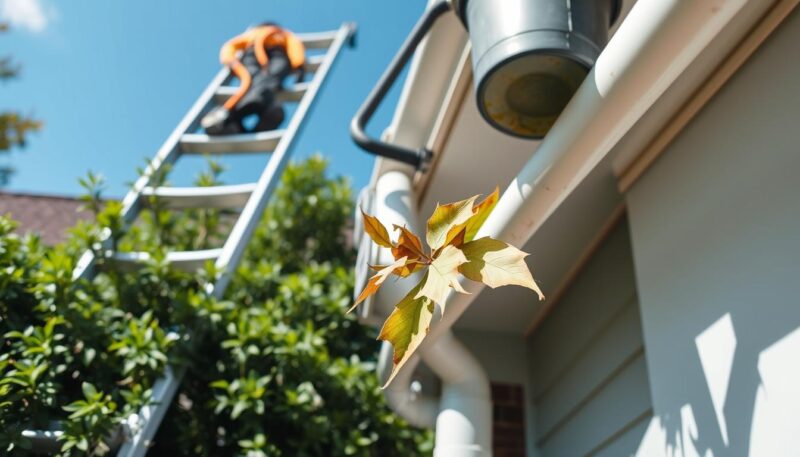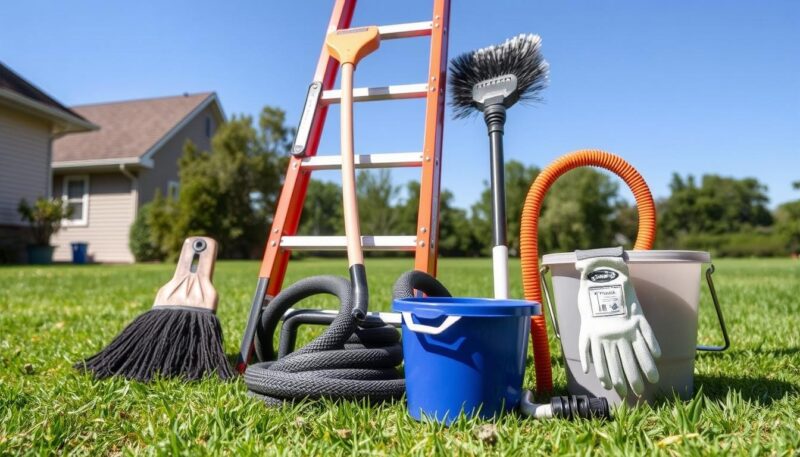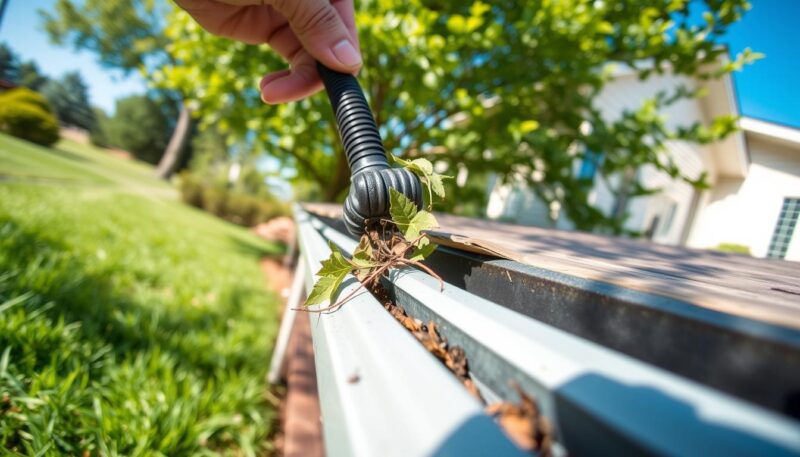Ensuring that downspouts remain obstruction-free is crucial to protecting your home from potential water damage. It might not be the most glamorous task, but regularly cleaning downspouts is essential for maintaining your home’s structural integrity and curb appeal. As you embark on this crucial maintenance activity, you’ll find that efficient rainwater management begins at the top of your home.
Properly unclogging a downspout ensures that water flows freely through your gutter system, preventing buildup and subsequent issues such as water damage to the foundation, mold growth, and pest infestations. Simple tools like garden hoses with spray nozzles and plumbing snakes can make the task more manageable. Additionally, professionals from HomeSmiles advocate for regular inspections to keep your gutter system performing at its best.
By adhering to these maintenance tips and incorporating DIY downspout cleaning techniques, you can extend the lifespan of your downpipes and avoid costly repairs. Remember, unclogging a downspout without a ladder not only makes the process safer but also mitigates the risks associated with heights. Pressure washing gutter downpipes can further enhance this practice, ensuring clear pathways for effective rainwater drainage away from your home.
Moreover, cleaning downspouts twice a year—particularly in the spring and fall—alongside inspecting downspouts after heavy storms, guarantees that your system remains functional. Installing gutter guards can also reduce the frequency of required cleanings by preventing debris from clogging your gutters and downspouts.
Let these cleaning frequency insights and maintenance tips inspire you to take proactive measures in safeguarding your home from water damage, ensuring a longer-lasting and more efficient gutter system.
Why Cleaning Downspouts is Essential for Water Damage Prevention
Regular cleaning of downspouts is a crucial aspect of home maintenance that helps prevent water damage. It ensures that water flows freely and is directed away from your house, avoiding costly repairs to roofs, walls, and foundations. Clogged downspouts lead to overflowing gutters, which can cause water to seep into the roof, under shingles, and into the house, creating rot and other structural issues.
Beyond structural damage, blocked downspouts can promote mosquito breeding and rodent infestations, turning your home into a dwelling place for pests. This highlights the importance of regular cleaning to foster a healthier living environment. By undertaking preventive measures, you aid in preserving both your natural and architectural surroundings, safeguarding your home against potential pest invasions.
- Inspect and clean gutters at least twice a year, especially in heavily wooded areas.
- Use professional maintenance services to ensure thoroughness in cleaning and inspecting gutters and downspouts.
- Consider installing gutter screens or guards to reduce the frequency of cleanings.
- Employ downspout extensions to channel water away effectively, preventing water pooling near foundations.
Effective water drainage protects landscaping from erosion and waterlogging. Overflowing gutters can destroy gardens and lead to additional expenses. By maintaining clear downspouts, you can extend the lifespan of your gutter system by minimizing rust, corrosion, and sagging. Thus, investing in high-quality materials for gutters and downspouts, and keeping them free of debris through regular cleaning, ultimately helps you prevent water damage.
Proper gutter maintenance, including the regular cleaning of downspouts, spares you from significant repairs. Well-maintained gutters efficiently divert water away, preventing damage to the roof, fascia boards, siding, and exterior paint, which can otherwise be costly to repair.
Seasonal cleanliness is essential as clogged gutters prevent effective water flow, causing overflow and backflow issues. This mismanagement can result in basement flooding and mold problems due to water pooling around the foundation. Regular gutter cleaning, particularly in areas with varied weather, maintains the integrity of the foundation by ensuring water is directed away from the house.
| Maintenance Component | Frequency | Benefits |
|---|---|---|
| Gutter Cleaning | Twice a Year | Prevents clogs, pest infestations, and water overflow |
| Professional Inspection | Yearly | Identifies potential issues early, extends gutter system lifespan |
| Gutter Screens Installation | As Needed | Reduces cleaning frequency, prevents large debris entry |
| Downspout Extensions | When required | Directs water away from foundation, prevents pooling |
Effective Tools and Methods for Cleaning Downspouts
Achieving efficient downspout maintenance begins with the right tools. Gathering the essential tools needed for cleaning downspouts ensures you can address and prevent clogs effectively.
- Identify the clog location by listening for solid tap sounds, observing any water overflow, or noting water spills. This step helps you pinpoint whether the clog is near the entrance or deeper within the downspout.
- Assemble necessary tools: a sturdy ladder, work gloves, plumber’s snake, trowel or scoop, bucket, and a hand mirror for inspecting less visible areas.
- Use a garden hose with a high-pressure nozzle to dislodge debris. Work from different angles, switching between spraying water and checking debris flow for any blockages.
For more stubborn clogs, a plumbing snake is highly effective. Available at most hardware stores in various lengths, this tool can penetrate deeper blockages, breaking them apart for easier removal. Wearing gloves and safety goggles protects you during this task.
Another powerful method involves using a leaf blower. By securely positioning your ladder and carefully moving the blower up and down the downspout, you can clear out tough debris. Remember to wear safety goggles due to flying particles.
After clearing visible debris, flush the downspout thoroughly with water using a high-pressure nozzle to ensure all blockages are removed. Regularly repeating this process helps maintain optimal drainage and prevents future clogs.
Installing downspout guards can significantly reduce the frequency of clogs by acting as a sieve and preventing debris from entering. After installing, always test water flow to ensure proper installation and functionality.
Safety is paramount when cleaning downspouts. Always use a stable ladder, have a helper nearby, and wear protective gear such as gloves, non-slip shoes, and goggles. Ensuring all tools are within reach can prevent accidents and make the cleaning process more efficient.
Regular maintenance is crucial. Inspect your gutters and downspouts at least twice a year, typically in spring and fall. For added prevention, trim overhanging tree branches and consider installing mesh screens or gutter guards. Keeping your downspouts secure and directing water away from your foundation helps prevent water damage and prolongs the lifespan of your home’s drainage system.
How to Clean Downspouts to Prevent Water Damage?
Effective DIY downspout cleaning is essential for maintaining your home and preventing costly repairs. Begin this process by gathering the necessary tools and materials, which include a sturdy ladder, work gloves, protective eyewear, a garden trowel, a garden hose, and a hand auger. Safety is paramount, so ensure your ladder is secure and your protective gear is in place before starting.
To start, remove any visible debris from the gutters using your garden trowel. This step is critical in water damage prevention as accumulated debris can clog your downspouts, causing overflow and potential damage to your home. Inspecting downspouts periodically is vital to identify any blockages.
After clearing the initial debris, flush the gutter system with a garden hose. This helps in removing smaller particles and ensures water flows freely through the downspouts. Observing how water flows through your gutters and downspouts during this process can reveal any issues, such as leaks or blockages.
Next, inspect the connections of your gutters and downspouts. Make sure all joints are secure and properly aligned. If you observe any signs of clogging, such as water overflow, sagging gutters, or no water flow during your tests, it might indicate a more severe blockage that needs to be addressed.
Using tools like a plumbing snake or a hand auger can assist in dislodging stubborn clogs. Regular cleaning frequency of at least twice a year is recommended for efficient water drainage. Homes with overhanging trees or those exposed to blowing debris might require more frequent cleaning.
Preventative measures are also crucial. Consider upsizing downspouts, adding drain covers or filters, and committing to regular inspections to ensure long-term protection against water damage. Installing a professional gutter protection system, like LeafFilter, can significantly reduce the maintenance required.
Routine maintenance is the cornerstone of preventing future clogs. By inspecting downspouts and cleaning them regularly, you ensure your gutter system remains functional and efficient.
To summarize the essential steps for effective DIY downspout cleaning, refer to the table below:
| Step | Action |
|---|---|
| Preparation | Gather tools: ladder, gloves, eyewear, trowel, hose, auger. |
| Debris Removal | Remove visible debris with a trowel. |
| Flushing | Flush with a garden hose to clear smaller particles. |
| Inspection | Ensure all connections are secure, inspect for clogs. |
| Removal of Clogs | Use plumbing snake or auger to dislodge blockages. |
| Preventative Measures | Install drain covers or filters, commit to regular inspections. |
Maintaining your gutters and downspouts by regularly inspecting downspouts and adhering to a consistent cleaning frequency will safeguard your home against potential water damage. Following these steps not only enhances your home’s appearance but also adds to its longevity and functionality.
Conclusion
Maintaining downspouts is not merely a task to enhance curb appeal; it is crucial for preserving your home’s structural health. Regular gutter maintenance, performed at least twice a year, can prevent significant water damage, pest infestations, and the accumulation of debris that could weigh down your gutters. Keeping your downspouts clean ensures the longevity of your roof, foundation, and exterior.
Cleaning your gutters is not overly complicated if you use the right tools and methods. A gutter scoop, cleaning wand, and a collection container for debris can make the process more efficient and safer. However, knowing when to call a professional is vital, particularly for hard-to-reach or severely clogged downspouts. Companies like Augustine Roofing offer professional services to tackle the more challenging aspects of gutter maintenance.
By consistently inspecting and maintaining your downspouts, you can avoid numerous issues that result in costly repairs. Clogged gutters can lead to structural problems, such as sagging or detachment from the house, and even attract pests like mosquitoes and rodents. This underscores the importance of regular gutter cleaning, ideally in the spring and fall, to ensure your home’s integrity and prolong its lifespan.



